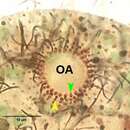Description of Pelagothrix plancticola
provided by BioPedia
Pelagothrix plancticola (FOISSNER,BERGER&SCHAUMBERG,1999) Diagnosis; Size in vivo about 80 x 55 um. Broadly ellipsoidal with anterior body portion laterally compressed and obliquely truncate. Cortical alveoli about 2.5 um thick. Body extrusomes 13 x 0.3 um, meridionally arranged. Many symbiotic green algae. 38 somatic ciliary rows on average. One ring of ciliated perioral dikinetids continuous with anterior end of somatic ciliary rows. Oral basket conspicuously trumpet-shaped, composed of 30-40 fine rods. Description; 1) Size vivo 55-100 x 35-65 um, usually around 80 x 55 um. 2) Body ellipsoidal with anterior third laterally distinctly compressed and obliquely truncate; lateral compression not maintained in silver preparations! 3) Macronucleus usually slightly above mid-body, globular. One micronucleus. 4) Contractile vacuole in posterior body end with many fine canals extending anteriorly along ciliary rows; single, conspicuous excretory pore in or near pole centre. 5) Cells green due to symbiotic algae about 5 um across in vivo. Extrusomes about 13 x 0.3 um, that is, long but very fine and thus easily overlooked; slightly curved, arranged in a row each between two ciliary rows, attached to pellicle and directed to body centre. No mucocysts recognizable in vivo and after application of methyl green-pyronin. 6) 34-41, usually about 38 meridional ciliary rows, each commencing with a basal body pair (perioral dikinetid; rarely two occur), loosened in posterior pole area bearing some scattered, 25 um long caudal cilia. Normal somatic cilia about 12 um long and moderately widely space. Cortex with very conspicuous, 2.0-2.5 um thick zone of pentagonal to hexagonal alveoli, which form bright fringe in vivo and impregnate with silver. 7) Oral opening in centre of anterior pole, circular. Oral basket trumpet-shaped (becomes conical under cover glass pressure), composed of 30-40 fine rods extending to near mid-body; individual rods furcate and merging subapically forming W-shaped pattern. Undulating (paroral) membrane composed of 30-40 dikinetids, each associated with an oral basket rod and a curved fibre extending anteriorly and then posteriorly to basket centre to form short, conical (inner) oral basket; encircled by single row of perioral dikinetids having short (about 7 um) cilia and being continuous with somatic ciliary rows. Brosse (adoral organelles) rather conspicuous because extending to mid-body and bearing 3-4 um long cilia having a curious, sigmoidal shape; indistinctly enklitoloph-dexiotrop (1-4 somatic ciliary rows abut at steep angles to right anterior brosse end), composed of 3-4 (usually 3) rows of oblique dikinetids having only the anterior basal body ciliated; right brosse or posteriorly continues as normal somatic ciliary row; details of oral ciliature recognizable only after silver impregnation and not necessary of identification. 8) Moves slowly by rotation about main body axis; does not jump.(From: Fissner,W.,Berger,J. and Schaumberg,J.Identification and Ecology of Limnetic Plankton Ciliates.Bvarian State Office of Water Management.Munich,1999).

